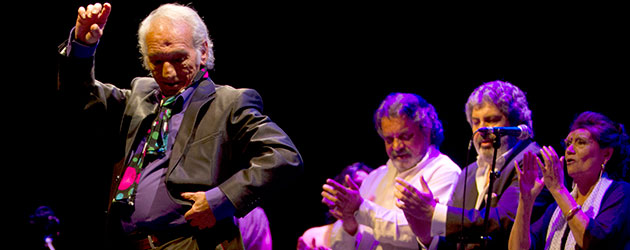Text: Estela Zatania
Photos: Jean Louis Duzert (C)
Wednesday, January 16th, 2014. 8:00pm. Teatro Bernadette Lafont, Nimes (France)
Nimes weather: a breeze from Extremadura brings high temps
In the world of flamenco, we’re always talking about roots, neighborhoods and families, of oral tradition and of stylization. There is also the tendency to attribute all flamenco to the region of Andalusia. But cultural expressions don’t know anything about imposed borders, but rather the people who cultivate, cherish and conserve those forms of expression.
Wednesday at the Festival de Nimes was the day of Extremaduran flamenco, a glorious niche of this artform. Extremadura, the westernmost region of Spain borders with Portugal, and a certain musical influence from the neighboring country can be detected. The Extremaduran interperters, mostly specialized in tangos and “jaleos”, which is what they call their relaxed way of doing bulerías, with distinctive styles that favor the luminous tones of C and G, have preserved a “canastero” sound that evokes simpler, more genuine times.
The first major star of this area was José Salazar Molina, “Porrina de Badajoz”, the man who put Extremaduran flamenco on the map. Last night, relatives and friends of his came to this town in the south of France to pay a heartfelt public tribute to their beloved maestro who would have turned 90 this year. For those of my generation, who remember the flamenco atmosphere of the sixties, the “Marques de Porrina”, an artistic handle the singer proudly defended with due legitimacy, was one of the great figures of the era.
At midday, writer and investigator Francisco Zambrano, biographer of Porrinas, offered his interesting talk “The Marqués of Porrina, flamenco ambassador of Extremadura”, which served to open both minds and appetites. Hours later at the theater, the tribute-recital directed by guitarist Miguel Vargas, began with singer Pilar Villarejo “La Ratita” and her brave delivery of tonás, malagueñas ended with the abandolao fandango from Extremadura of Pérez de Guzmán, and siguiriyas. The great professional singer Antonio Suárez “Guadiana”, sang soleá and tangos, in addition to mining cante which so often forms a part of the Extremaduran repertoire, and lets these singers romp freely in the orientalism so typical of their music. José Salazar “Xhulo” also sang, por soleá and bulerías, with the peculiar and specific swing of the singers of Extremadura.
It’s fascinating to see how in all the music these people make, the aroma of Extremadura is always present. Occasional notes unexpectedly flattened, melismas that travel unusual routs…even a “standard-issue” soleá of Frijones comes out with that unmistakable flavor. It’s a delivery we are tempted to think of as “Camarón-style”, but it was Camarón himself who picked up that stylization from them, from Ramón el Portugués, Marelu and Juan Cantero, just as did other young singers of the era such as Juan Villar and Turronero who spent long periods in Madrid, making it possible to pick up the exotic Extremaduran sound.
The unquestioned stars of the night were the old-timers, Josefa Salazar “La Negra”, daughter of Porrinas, a tiny lady with a crusty singing style won everyone over with her cantes that were not learned but rather “received”, and the surprising elegance of Antonio Silva “El Peregrino”, now dancing even better and more confidently now at seventy-something that he did two years ago when he performed at this festival.
